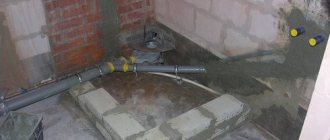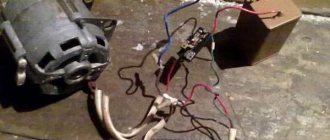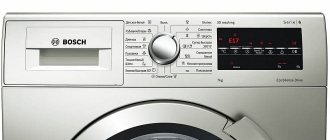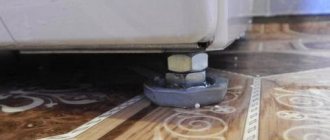Like most household appliances, the operation of a washing machine is aimed at facilitating human labor and performing everyday tasks. The device runs on electricity and uses water. However, some parts necessary for the high-quality performance of specified operations should, in principle, not come into contact with moisture. To prevent water from getting into some parts of the washing machine and to ensure that it lasts a long time, special devices were designed - oil seals and cuffs.
Like other parts of the device, they require proper care. Washing machine seal lubricant increases the life of bearings by preventing water and moisture from entering them. Why is it needed, how and when should lubrication be carried out?
What is an oil seal?
This is a dense technical material located at the joints of parts. It is this that prevents water from entering the technical departments and protects the internal structure of the machine. In fact, not a single model of washing machine can do without it, regardless of the manufacturer. The only difference that may be is the shape and size of the seal.
The specific properties and characteristics of the device directly depend on what material is used to make the oil seal. As a rule, they are made of silicone rubber or rubber. During the manufacturing process, a special metal insert is most often used, thanks to which the product retains the desired shape in the future and is not deformable.
If we talk about frontal ones, then in them the drum is mounted on a bracket with several special paws. A semi-shaft is mounted nearby, which helps fix the entire structure. In addition, it retains its mobility, due to which the drum begins to rotate during operation. The oil seals are initially located on the bushing. In tandem they prevent leaks. Complete safety for other mechanisms is ensured. In the absence of any damage, the entire structure, including the bearings, is as if in a waterproof valve. If moisture gets on the bearings, then after a while they begin to rust and quickly stop doing their job.
Diagnostics
Most modern models of Bosch washing machines, for example the Maxx 5-6-7 series, are equipped with a self-diagnosis system, which greatly simplifies the identification of faults. In order to establish the nature of the breakdown, it is not necessary to contact the service center; it is enough to perform a few manipulations, and your machine itself will “tell” what the problem is. So, let's start performing the service test:
- Close the sunroof, move the program selector to the “Off” position.
- Pause for 2-3 seconds, move the switch to “Spin” (clockwise).
- When the Start LED flashes, press and hold the Mode Speed button. Watch "Start" - it should start flashing again.
- Turn the switch to "Drain" (clockwise).
- Release “Revolution Mode” (you didn’t forget to hold this position, did you?).
- Next, put the switch in the position corresponding to testing any component of the washing machine (3 – motor, 4 – drain pump, 5 – tubular electric heater (TEH), 8 – main wash water inlet valve, 14, 15 – quick automatic test). Below is a diagram of the switch and the location of the numbers that correspond to the position of its handle.
Here is a schematic image of the switch and an explanation of the positions of its handle.
Some models differ in the numbering of commands: for example, in the Bosch Logixx 8 washing machine, the motor is checked in the 4th position (by the way, in this washing machine you can carry out quick diagnostics by setting the switch to number 3). When the test is completed, an error code will appear on the display, which the instructions will help you decipher. In older models without a display, the error can be recognized by the glow of the LEDs, after which you can begin to repair the Bosch washing machine.
The photo shows the control panel of the Bosch Logixx 8 washing machine; Diagnostics of breakdowns in it is carried out according to the Bosch Maxx principle, only the numbering of commands is slightly different
It is somewhat more difficult for owners of older generation models - they will have to determine the breakdown based on its symptoms.
Signs of malfunctions and their causes
Devices from earlier years, for example Bosch WFT 2830 or Bosch WFF 1201, cannot independently diagnose problems, so the user will have to do this based on their characteristic symptoms:
- Water is collected slowly or not at all. This occurs due to the accumulation of debris in the inlet filter or a malfunction of the fill valve. The culprit of the breakdown may also be the water level sensor - pressure switch;
- water does not drain well. The problem most often lies in a clogged drain filter, failure of the drain pump or pressure switch;
- the water does not heat up. The heating element is almost always to blame for this. The heating element burns out for two reasons - natural wear or scale formation. Sometimes there is no heating due to problems with the control board or a malfunction of the temperature sensor;
- The drum does not spin. A belt drive transmits torque from the engine to the drum. If the belt falls off or breaks, the drum will not move. A more serious option is engine failure;
- loud noise during spin cycle. The reason usually lies in the destruction of the bearings.
In the photo Bosch Maxx 4 WFC 2060 is a model equipped with a self-diagnosis function
Any of the listed problems can be caused by a failure of the control module (electronic controller). Unfortunately, it is very difficult to repair this unit yourself; it is better not to try. Contact a service that provides repair services for Bosch washing machines at home. Specialists will resolder the board or replace it with a new one.
What lubricant should I use for the washing machine oil seal?
After replacement, the sealing device requires mandatory treatment. The ideal option is a waterproof lubricant for washing machine seals. It is purchased in specialized stores that sell components for repairing household appliances. In addition to water resistance, lubricant for oil seals for washing machines must have the following characteristics:
- It should not contain chemicals that can corrode rubber or soften it (as a rule, sealing parts are made from this material). A lubricant that is not suitable in its composition will not perform its intended functions, but will only reduce the service life of the oil seal.
- Increased heat resistance. The specificity of the oil seal is such that when the washing machine is operating, it comes into contact with the shaft, and during friction and exposure to hot water, the temperature of the parts rises. Therefore, the composition that will soften sliding must withstand rising temperatures. High-quality lubricant for oil seals for washing machines can withstand temperatures up to 180 - 200 degrees.
- Thick composition. This is an important indicator of good lubrication. Because during operation the liquid solution will simply flow out.
If the owner of household appliances carries out repairs with his own hands, and he has a question about which lubricant for the washing machine oil seal is better, then you need to choose it according to the above criteria, and not according to the manufacturer. In any case, in any normal specialized store, sellers will advise the required composition; you just need to explain its purpose.
Cleaning internal contaminants
To do this, use a screwdriver to pry the latch on the motor body on both sides and remove it from the reel.
There are also so-called “non-separable” motors, but they can also be “treated”.
After disconnecting the body with the blades from the coil, we will see a monolithic part. The crosspiece seems impossible to remove. But there is a little trick.
- Take a regular hair dryer, set it to the lowest temperature, put on gloves, and start heating the shank of the part (its long part). Do this with care.
- After a while, when the shank has warmed up well, pry up the crosspiece with a screwdriver and carefully remove it (along with the magnet) from the body.
There may be a lot of dirt on the magnet and in the area from which it was removed. Everything needs to be thoroughly cleaned, after which you can remove the magnet itself from the shaft. You will see a bearing that requires cleaning and lubrication, respectively. Also lubricate the bearing on the bottom of the housing.
Then insert everything into place, with slight pressure until it clicks. The O-ring located under the blades should fit tightly into place.
The figure below shows a dirty motor from an Indesit brand machine.
In motors of this type, in addition to the above procedures, it may be necessary to replace the seals.
Grease for washing machine oil seal: what to replace?
The best option would be to use those substances that were recommended by the manufacturer of the washing machine. Many manufacturers produce branded lubricants, which, according to them, are suitable specifically for one or another model of household appliances. But in fact, these are standard compounds that are suitable for any oil seal. Unfortunately, not everyone can afford even such lubricants, since this pleasure is not cheap.
As alternative good options, you can choose the following types of lubricants intended for machine maintenance:
- "Litol-24".
- "Ciatim-221".
- Azmol-Alumina.
- Ambligon.
Of course, there are many similar options, but the above listed compositions have already been tested more than once on a wide variety of models of washing machines and have shown good results during use.
Diagnostics
The first stage of diagnosis is to check for signs of incorrect pump operation. Before disassembling the structure, you need to make sure that the malfunction is related to the pump. A breakdown can be identified by the following symptoms:
- the water drainage mode has been activated, but the pumping system is not functioning;
- during the draining process, loud noise and buzzing are heard;
- the pump pumps out water, but more slowly than initially;
- During washing, the machine turns off spontaneously;
- You can hear the hum of the pump motor, but the water does not drain.
If one of the listed breakdowns is present, the pump will most likely need to be repaired. Before proceeding with dismantling and repair, you need to carry out diagnostic steps. To check, remove and clean the drain hose to get rid of the blockage, and then wash the filter. Next, include a test wash in the rinse and drain mode, and if the steps performed did not help eliminate the problem, you should proceed to repair work.
Why do you need an oil seal?
This is a round seal. Material: rubber. Its function is to seal the gaps between moving and non-moving parts. In an automatic washing machine (AWA), a sealing rubber ring is necessary to prevent leaks in the tank. Drum bearings are parts that protect against moisture. It is the seal that protects them from water.
To ensure tightness, a rubber ring, placed on the shaft and inserted into the bearing, is attached with maximum density - this prevents water from flowing out through the joint gaps. Rotation of the metal bushing with the seal attached to it leads to increased wear of the rubber. To slow down wear, you need a special water-repellent lubricant.
Expert advice
Professional technicians who service machines know several causes of breakdowns that do not lie on the surface, but affect the performance of the pump:
- Particularly “bouncy” machines can fray the power supply wires of the pump during washing. Then the pump will appear to be in good working order, but will not work and spin. To diagnose this problem, you will need to disassemble the device down to the electronic control unit. This repair is quite labor intensive. Only a master can handle it; a beginner cannot repair it.
- In some cases, the electronic control unit program may fail. Such diagnostics and repairs can only be performed by a professional technician with special equipment.
- Another rare malfunction is a blockage in the hose running from the main tank to the volute with the pump. It can be determined by hand, squeezing different areas in turn. If necessary, the hose can be removed and cleaned under strong pressure from the tap.
Most often, technicians check the contact group and the pump impeller. If the cause of the breakdown does not concern these parts, the specialist simply replaces the entire assembly.
You can repair the washing machine pump yourself. This is a simple operation, especially if you have an assistant. When working, you need to take precautions, do not forget about the remaining water in the tank and do not try to repair or solder the pump unless the impeller or contact group is involved.
How to replace the oil seal?
The process is similar to replacing bearings:
- The washing machine is disconnected from the power supply. The water is drained.
- They are sorting out the SM. To change the tank seal of a washing machine, you have to disassemble almost the entire device. Remove the top cover, then the front and back panels.
- The drive belt is removed from the drum. It is necessary to prevent the pulley from moving; to do this, it is stopped with a hammer. Unscrew the bolt located in the center of the pulley. Remove the pulley.
- Disconnect the wiring. Most often it is secured using plastic clamps - remove them with wire cutters. After the wiring is disconnected, remove the engine. The wires from the heating element are also disconnected.
- Unscrew the bolts and remove the upper counterweight. Take out containers for the powder. Unscrew the fasteners holding the control panel and remove it.
- Disconnect the fill valve by loosening the clamp. Take out the container for the powder and the valve along with it - having first unscrewed the wiring and mounting bolts.
- Take out the pressure switch hose attached to the tank. Open the hatch door and, bending the seal, remove the clamp. The cuff is tucked inward. Unscrew the lock and unfasten the wiring.
- Unscrew the fastening joints and remove the counterweights. Unscrew the shock-absorbing elements and remove the tank from the hooks. They get him. That's it, the main thing is done - the tank is removed. All that remains is to find out how to get the old rubber ring out and how to install a new one.
- Unscrew the screws securing the tank. Using a screwdriver, release the latch mechanism and remove the cover. They hit the bushing to remove the drum.
- Pry up the seal using a screwdriver and remove it.
Is it difficult to find a pump?
The location of the drain pump is standard in almost all LG models, regardless of whether the machine has a direct drive or a belt drive. Moreover, getting to the location of the malfunction will not be difficult - you will not have to completely disassemble the case. There is also no need to even unscrew the back wall, top cover, tray or front panel. Finding the pump is much easier, since it only requires a series of simple steps.
- Disconnect equipment from electricity.
- Drain waste water from the drum using the emergency drain.
- Shut off the water supply and disconnect from the sewer.
- Tilt the body back, placing old rags under the machine.
All. We look under the bottom and get free access to the entire drain system. There is another way - move the machine to the center of the room and place it on its left side.
What are the requirements?
Sunflower or other household oil is not suitable here. The substance used to lubricate the sealing ring has special requirements.
- High moisture resistance. Otherwise it will quickly wash out.
- No aggression towards rubber - it should not corrode or soften. By choosing the wrong substance, you will shorten the life of the seal.
- Heat resistance. Due to the friction of the shaft and the operation of the bearing unit, the rubber heats up. Hot water should also not affect the properties of the sealing element.
- Sufficient thickness. Liquid consistency is not suitable - it will leak out after some time.
Causes of pump failure
- The pump broke down due to a malfunction of the engine, as a result of which there is no voltage to the pump.
- The seal (rubber or plastic) is damaged by scale and dirt that settles on the impeller.
- Incorrect connection of the pump or failure of the water level sensor causes the pump to constantly operate.
- The pump will not be able to drain water due to a clogged filter.
- Small foreign objects destroy the impeller. It's easy to diagnose. When the pump starts, the machine makes a hooting sound.
How to lubricate the oil seal?
Contact specialized stores for lubricants. Specify why you are taking them, and the seller will suggest a suitable option. But keep in mind that such a product is not cheap, as it is highly specialized.
Anderol for washing machines
Lubricant made in Italy. Chemically neutral. Excellent moisture resistance. Maximum operating temperature: + 190 degrees. Not afraid of heating. For any seals.
Amblygon - lubricant for oil seals
This is another Italian version. Works at the same temperatures as Anderol. Repels water, not aggressive. Packaged in syringes with a capacity of 2 ml, as well as in 100 gram tubes.
Litol-24 and 24 M
A universal product - suitable for different purposes. When heated, it does not become harder or stronger. High stability in mechanical and chemical terms. Range: minus 40 – plus 120 degrees. Properties of modification 24M - no compaction in an aqueous environment, mechanically stable, can be combined with other lubricating compounds.
Possessing high moisture resistance, it is ideally suited in its parameters for the stated purpose. When purchasing, pay attention to the details: you need a substance with a thick consistency, moisture- and heat-resistant. All these parameters must be indicated on the packaging.
The best option is LIQUI MOLY Silicon-Fett. Operating temperatures - from −40 to +200 degrees. This is the most suitable option - experts advise using it.
Experts advise not to skimp on lubrication. It is not recommended to use Litol, Tsiatim, Amzol and other cheap compounds. After them, the washer starts to creak - you have to change the bearings again.
Automatic washing machines are indispensable and the main assistants of our housewives. They save a lot of our time, which we can additionally spend on work, our hobbies or family.
Automated units save energy, water and washing powders with great precision, thereby justifying their considerable cost. When washing in a machine, many times less water is used than in labor-intensive manual processes, and accordingly, less powder is consumed to achieve the washing solution of the required concentration.
But like any equipment, washing machines require periodic maintenance and repair. Despite the direct contact of many parts of these products with water, many components of washing machines are protected from moisture getting on them.
Many components are protected by special sealing gaskets, cuffs and oil seals, and if these safety elements are damaged or worn out, other parts are subject to rapid deterioration. To avoid additional costs for repairing your assistant and to correctly carry out preventive maintenance and maintenance of the product.
- At the first sign of a malfunction, you need to take measures to eliminate it. In case of leaks, it is necessary to eliminate the tightness of the connections of the prefabricated units, and if noise occurs, pay attention to the bearing unit.
- Noise at high speeds or the appearance of grease on things indicates that the bearings need to be changed in the washing machine. The ring-shaped rubber band serves the function of insulating the bearing assembly from possible moisture ingress due to bearing corrosion and failure.
- A common reason for rapid wear of the oil seal is frequent washing at high temperatures. The rubber from which the part is made requires such heating, but due to frequent heat treatments it loses its elasticity.
- When replacing bearings, the oil seal must also be replaced with a new one, which in turn is lubricated with a special lubricant. The composition of washing machine lubricant for oil seals should make it water-repellent and not change its properties at high temperatures. In this article we will look at how to properly lubricate a washing machine part and with what.
The part has the shape of a ring filled with rubber, the inner diameter of which seals the shaft rotating inside. When subjected to friction, it is subject to high heat and must be lubricated to avoid rapid wear and loss of seal.
In the absence of lubrication inside, the oil seal quickly wears out and leads to malfunctions and breakdowns of other parts of the mechanism, such as the bearing assembly. Replacing the oil seal of a washing machine must be accompanied by lubrication, otherwise the repair performed will have to be repeated in the near future.
Grease for washing machines can have a variety of names, colors and packaging, but must meet certain requirements:
- Be water repellent. Many people think that all lubricants, due to their greasy appearance, have this quality. This is far from true. Before use, be sure to make sure that your lubricant has a water-repellent effect. This will significantly increase its service life;
- Withstand high temperatures without changing its properties. The washing machine involves heating water to boiling and the rubber part is directly subjected to this heat treatment, so the lubricant should not spread or harden;
- Neutrality to the oil seal rubber. The lubricant should not be aggressive to the rubber composition of the part; it should not affect its elasticity and resilience.
Selecting a pump for washing machine repair
If the pump has served for more than 5 years, and diagnostics show the need to replace it, you will need to purchase a new one. To increase the service life of your pump, you need to choose it correctly.
When choosing a pump, consider the following parameters:
- Attachment to the cochlea : with 3 screws or 3, 4 and 8 latches. The mountings of the new pump should be the same as the old one. Otherwise, it simply won't fit.
- Method of connecting wires : “chip” and “terminals”. If, instead of a pump with a chip, you purchase a model with terminals in the form of terminals, you will need to trim the double wires at the end, strip and install the terminals.
- Placing a contact group . Can be located behind or in front. The location doesn't matter much. This does not affect the operation of the pump.
- Manufacturer of drain pumps . There are several universal brands: Coprecci, Arylux, Mainox, Hanning, Plaset, Askoll. Pumps from these manufacturers are interchangeable.
- Pump power indicated on the sticker. This parameter is not very important, since it is approximately the same for all models.
It is difficult for an ordinary person to understand the design features of pumps, so when choosing a new device, it is better to consult a professional.
Image gallery
Photo from
Pump with output in the form of a “chip”
Connecting wires to the pump to the terminals
Rear position of the contact group
Placing the contact group at the front
The design diversity of drain pumps is, first of all, determined by the features of the plastic pipe (volute) and the debris filters combined with them.
In modern models, manufacturers use three types of pumps:
- on three volute screws ( Samsung, Indesit, Ardo );
- on three volute latches ( AEG, Bosch );
- on eight snail latches ( LG, Zanussi ).
Pumps of the same type are interchangeable. For example, a Samsung pump is suitable for an Indesit brand car and vice versa.
What lubricant to use for the washing machine oil seal
Nowadays there is a large selection of lubricants on the market and any table of spare parts for washing machines also includes its availability. There are specially designed options, but the point is that you won’t need a whole package to carry out the repair yourself, and it will cost a lot.
Packages usually contain 50-100 grams of material, and with lubrication you will need 1-2 grams.
Here are some of them
:
- Huskey Lube-o-Sela lubricant (100 g - packaging);
- Hydra lubricant (100 g).
If there is no original lubricant, the washing machine oil seal can be lubricated with others, the main thing is that they meet the requirements of their future operation.
At home, you can lubricate the oil seal of a washing machine with the following lubricants:
:
- Litol (or Litol-24). It has chemical and mechanical stability in the temperature range from 40 to +120 degrees Celsius.
- Cyatim 221. Performs excellently in high friction units and does not change its basic properties at temperatures up to +150 degrees.
Also many automotive and other solid lubricants, of which there are a huge number today, including silicone analogues of washing machine oil seals.
Required Tools
Repairing the pump is simple, as it does not require many tools or special devices. Most often, three things are enough for dismantling and repair:
- Phillips screwdriver;
- sharp knife or chisel;
- electric voltmeter.
Pliers or pliers are useful as auxiliary tools to remove the clamps from the hoses.
Prepare a dry rag and bucket in advance . There will likely be a small amount of water in the pump that will spill onto the floor.
How to properly replace the seal in a washing machine
The process of processing the bearings and oil seal does not take as much time as the process of disassembling the washing unit itself will take. In order to get to the oil seal, you will need to disassemble all or most of the machine, remove and disassemble the tank, and in some cases, cut it.
But at the first signs of oil seal wear, it is better not to delay replacing it. Moreover, this will still have to be done soon, but if you delay it, the repairs will become more difficult and require a much larger budget. Many washing machines do not require complete disassembly; you just need to remove the rear inspection window, dismantle the hub and carry out the process of replacing and lubricating the parts.
For example, a large number of vertical models are equipped with removable hubs on the outside of the tank. Replacing them does not take much time, but they cost quite a lot. And in vertical machines there are two of them, on different sides of the product, which usually has two covers for removing the necessary components, which makes your work easier.
It is precisely in this case that it is necessary to lubricate the necessary parts in a timely manner in order to increase their service life. Installing the washing machine oil seal when replacing bearings is a mandatory procedure that requires special attention. After removing the old rubber and worn-out bearings, it is necessary to thoroughly clean and lubricate the hub before installing new parts.
After installing the bearings in the washer, you need to correctly place the part with a spring inside the hub. A waterproof lubricant for washing machine seals should be placed inside it. Oil seal lubricant can be original or similar. After this, carefully insert the washing machine drum shaft into the hub with new parts, first clean the bronze bushing on the shaft.
It is recommended to carry out the first test wash with detergents at medium temperature in order to remove any grease that may have gotten inside the tank. Maintenance should be carried out periodically to remove all kinds of accumulated dirt and scale that affect the elasticity of rubber parts.
You should also pay attention to the quality of the powders used when washing and do not abuse high temperatures, especially since this does not have a very favorable effect on the quality and durability of the items being washed.
The oil seal is perhaps the only part that is in direct contact with the engine shaft, and therefore, lubricant for oil seals is absolutely vital. Otherwise, during the friction process, this part will very quickly fail.
The price of the oil seal is mere pennies, but if it is destroyed, very soon a sad fate will befall the bearing, the price of which in the store is quite high.
The oil seal is a rubber ring that serves to seal possible leaks between static and moving parts of rotating mechanisms.
Replacing a bearing is an operation that will happen one way or another if your SMA is in use for long enough. In principle, this procedure is not complicated; it can be said to be quite routine. But there is one significant “but”. If you replace the bearing, but ignore such a step as lubrication, then all the work will go down the drain and, alas, you will have to pay twice in the store.
A seal running “dry” will very soon wear out and begin to leak water. This, in turn, will quickly destroy the bearing. Thus, there is no doubt - lubricating washing machines is a necessary operation, and neglecting it, as they say, is more expensive for yourself.
So, we agree that lubricant for oil seals is necessary. Now, to solve the problem formulated above, let’s try to answer the question of which lubricant for washing machine oil seals is best suited.
How to prevent pump failure
If you follow these recommendations, you can significantly extend the life of the drain pump.
Always remove foreign objects from pockets before washing.- Use bags for washing clothes.
- In case of strong, coarse dirt, clean things, and also remove animal hair by hand before entering the machine.
- Install filters at the inlet of the filler pipe.
- Carry out scale prevention.
- When washing items with buckles or rivets, turn the items inside out.
Analysis of materials
To solve the question of how to lubricate a bearing in a washing machine, we need to understand what we want to get.
- moisture resistance. A necessary requirement that needs no comment is that waterproof treatment is a priority;
- the lubricant must be neutral in relation to rubber, otherwise the oil seal will quickly fail;
- The oil seal is constantly exposed to friction, and therefore to high temperatures. Therefore, one of the requirements for the oil seal must be its heat resistance;
- In order for the product not to flow out, the consistency should be viscous.
Signs and causes of malfunction
If your washing machine does not have a self-diagnosis system, the following signs will help determine the problem:
- The drain program has started, but water remains inside the tank.
- An extraneous sound is heard when pumping out liquid.
- The water leaves very slowly, some remains in the tank.
- The equipment turns off until the drain is completed.
- The control board freezes while draining water.
- The pump hums, but the liquid is not pumped out.
If the user detects at least one or two such signs, this means that the pump has become unusable. To eliminate other possible breakdowns, it is necessary to check the drainage system - hose and filter - for blockages. If there is no debris in them, then you need to disconnect, remove the pump, disassemble, clean or replace it.
The most common causes of pump failure are:
- Wear of motor bushings.
- Short circuit or break in the motor winding.
- Blocked or broken impeller.
Lubricant selection
Immediately remove the following message: you cannot skimp on processing lubricants for oil seals. Go to the store and choose. Good material in the store is expensive and you have to agree with this. Another thing is how to choose a reliable and durable one from the abundance of expensive products.
Let's try to conduct a short review of the materials. When visiting a store, you need to remember that some products can be replaced, and some can be completely removed from the agenda. The top five best impregnations for SMA oil seals include the class of silicone lubricants.
What if you don't have running water?
There are machines that do not need a high-pressure hose, a pump, or even a water supply. Similar cars are produced by the Slovenian brand Gorenje. A tank of 100 or more liters is attached to their body. The user fills the container himself. And then the washing begins, as in a regular SMA.
Machines with reservoirs have a built-in pressure pump. The pressure is enough for effective washing - its quality is not inferior to that of conventional models. Depending on the displacement, one container is enough for several cycles. There are few offers on the market - only a few models.
Such modifications have a significant disadvantage - the container has a narrow neck, through which it is problematic to wash it. But compared to the fact that this SMA allows you to wash without running water, this is a trifle.
Advantages of silicone lubricants, what to replace?
Wherever silicone-based materials are used! In dentistry, plumbing, printing, etc. Since the temperature range of silicone materials ranges from -45 to +300 °C, they are also used in precision electronics. Silicone material forms on the surface being treated a saturated layer of polymer material consisting of uniform silicone molecules. He is:
- slippery and water-repellent;
- adhesive (ability to adhere to any surface) to metal, rubber, plastic;
- effectively resist friction.
Experts recommend using specialized products for washing machines, without resorting to proven products such as Tsiatim, Litol or Azmol. For consultation, contact any specialized store. The effect of using these funds, of course, will be, but, alas, not long-term. Very soon the bearings, under the influence of an aggressive environment, will begin to “creak” and “crumble.”
When to add water?
During normal operation, the inlet valve receives a signal from the control module. As a result, the valve opens and the liquid is filled. If the pump is turned on and the valve remains closed, an emergency situation occurs. For the convenience of supplying water to the washing machine, the following option is offered:
- Unscrew the screws on the top cover. Remove the cover and underneath it is the valve.
- There are 2 wires suitable for the valve, to which terminals are connected. The latter are connected to 2 wires leading out. They are connected to the power supply according to the diagram below.
- The output is a relay. It is connected to the pump. It turns out to be a kind of water pressure machine for the pump. A connection has appeared between the valve and the pumping device - as soon as the machine gives a signal to draw water, the relay is activated and the pump starts working. This scheme is easy to implement without the help of specialists. It will allow you not to sit near the device, watching it fill.
Which lubricants are better?
Litol-24. Production: mineral oils are thickened with a mixture of lithium technical soaps with the addition of antioxidant additives. Pros: waterproof, high chemical and thermal resistance. If you remove the temperature range, it will be from -45 to +139 °C. Adequate replacement for SHELL.
CIATIM-221. The advantages include resistance to high temperatures and stability during prolonged friction, which has a positive effect on the operation of the bearing seal; waterproof. The downside is weak hygroscopicity, i.e. With constant exposure to a humid environment, the material becomes unusable, although this process can take years. A good replacement is the SHELL series.
LITIN 2. In this case, we are dealing with a highly specialized product intended for use in extreme conditions on vehicle components, which means it has a multiple margin of safety and “survivability.” This product has proven itself to be a worthy replacement for products from a brand such as SHELL, which in itself is a high indicator.
CIATIM-201. This product has found its application in friction points of aircraft equipment, where it is necessary to relieve high thermal stress. The lubricant remains operational for more than 600 hours of flight time.
CV joint-4M. Used in extreme motorsports to lubricate ball suspensions and joints of racing cars. It has unique antioxidant and extreme pressure additives and is extremely waterproof.
It should be understood that any material can be removed and replaced with an analogue. Thus, when choosing a lubricant in a store, you should first of all focus on the price according to the principle “good things cannot be cheap,” and the use of the product is designed for at least years to come.
What pressure does the pump create?
There are different models of pumping equipment on the market. Let's look at the most popular options. The proposed equipment increases the pressure to 3.5–6 bar. All models have overheating protection.
- Wilo PB-088EA. Costs 3,800 rubles. 3.5 bar. Temperature - 2–60 °C. Installation - horizontal or vertical. Throughput - 2.4 cubic meters/hour.
- Grundfos UPA 15-90. Price - 5,500 rubles. Passes 1.5 cubic meters/hour. Installation - vertical. For clean water only. 6 bar. Noise - 35 dB.
- Gilex Jumbo 60/35 P-24. Price - 5,400 rubles. 3.6 cubic meters/hour.
- Marina Cam 80/22. Surface pumping station. Costs about 9,000 rubles.
The maximum pressure in the above models is 9.8, 35 and 32 m, respectively.
How to lubricate?
Now let's look at the algorithm step by step on how to lubricate a bearing in a washing machine.
In this article, we consider the process of disassembling the SMA purely briefly. Our task is to apply the necessary products to the oil seal. Our steps: unscrew the 4 bolts and remove the back cover, then remove the belt. Remove the bearing block cover and unscrew the main bolt. Remove the bearing. Unscrew and remove the product holders, then release the seal.
Questions such as how to remove this or that block and then replace the part are the topic of other articles. So, remove everything that needs to be removed, unscrew and disconnect the necessary parts. Before us are a bearing and an oil seal. Then the oil seal must be lubricated. Unscrew and remove the cap, disconnect the feeding device - the product is ready for use.
As a rule, the product is packaged in a tube, which simplifies the process of use: unscrew and remove the cap and it is ready for use. So, unscrew and remove the cap and then apply the product. First, you need to apply the product to the outer contour of the oil seal, trying to do it evenly, without leaving dry areas. To do this, remove the cover, unscrew the bearing from the seal, then remove the cover and place the seal in the niche provided for it, then remove everything else.
Where is the pump located
Models of washing machines Candy, LG, Whirpool, Ariston, Beko, Samsung are equipped with a pump located at the bottom. To get to it, the washing machine is laid on its side and the bottom panel is removed. The snail with the filter is attached with screws that can be unscrewed and the required part is in your hands.
If we talk about Zanussi and Electrolux models, their pump is located behind the back cover, which will need to be removed.
The most difficult models to disassemble are Bosch, AEG, Siemens. They will have to dismantle the entire front panel.
The principle of operation of the pump, its application and location
During operation of the washing machine, water is supplied inside the device under pressure, that is, the intake occurs automatically as soon as the necessary programs are selected and the “START” button is pressed. The process then proceeds according to the following scenario:
- the solenoid valve is brought to the open position;
- a pressure switch (sensor for monitoring the liquid level in the tank) measures the required volume of water;
- the path of the liquid runs through the compartments where the necessary detergents (washing powder) are located, water mixes with them, and thus enters the tank in dissolved form;
- the liquid under pressure enters in the required volume into the chamber where the laundry is stored.
During the process and completion of the wash, the water pump comes into play. It is he who drains and pumps out dirty waste liquid after washing or excess water after rinsing. The pump is involved in almost all washing modes!
As soon as a signal from the electronic module is sent to the pump, waste water will begin to be pumped into the sewer due to the impeller of the device. The fluid path is as follows:
- Water enters through a rubber pipe, which is connected to the tank and volute using special clamps
- Next, the liquid enters the pump through a special filter located in the volute; it protects the pump impeller from debris, to avoid jamming of the impeller.
- Next, the liquid comes out through the drain hose, which is connected to the volute. The dirty liquid phase is pumped out until the waste liquid is completely pumped out of the washing machine tank.
During washing, the water is already in the lower part of the unit, which is why the end of the drain hose must be secured above the drain pump, since if this is not observed, the water will begin to drain from the machine by gravity. The drain hose must be installed at least 80 cm along its entire length!
The electric drain pump is located at the bottom of the unit under the tank. It is attached to a plastic volute, usually with three screws, and the volute, in turn, is attached to the body of the unit from the front side. This arrangement is convenient for quick access to it, if, for example, you need to clean it of debris or drain liquid from the system.
There are two types of pumps used in washing machines:
- The circulation type of pump is used in conjunction with a conventional pump; they are used in new models of premium class machines such as Indesit, Ariston, etc. This option supplies water directly to the washing area and circulates throughout the system, which improves washing efficiency.
- machines from a more budget type or not of a new generation, such as the Daewoo bubble machine (Daewoo), are equipped with a simple pump, for example from Askoll, which simply drains the waste liquid into the sewer.
Repair of the drain pump of a washing machine, as a rule, is not carried out; most likely, spare parts in such devices will have to be replaced. That is, you will have to completely replace the broken pump with a new one.
ATTENTION! You can also inspect the device yourself for blockages or pump failure. But when inspecting the internal mechanism, you must first disconnect the equipment from electricity. Using a special device, such as a multi-mmmeter, check the contacts going to the pump and make sure there is no voltage, and only then continue working. All these precautions are necessary because the work is carried out near an open source of water.
Operating rules
With proper care, an SMA pump lasts an average of 9-11 years. To prevent this period from being shortened, you must:
- ensure that the water is sufficiently clean (you must ensure that there are no foreign objects in the laundry pockets, and also remove pieces of dried dirt before washing);
- monitor the serviceability of filters;
- prevent the appearance of scale (for this it is recommended to use special water additives);
- Completely empty the tank upon completion of washing (wait until 100% of the water in the working tank has been pumped out).
It should be noted that if the pump does break, it is never repaired, but replaced with a new device. Moreover, this should only be done by a qualified specialist.
You may be wondering why the drainage of water into the SMA does not work.
What determines the cost of repairs?
When calculating the cost of services for replacing the drain pump, we take into account:
- Car model;
- Pump type;
- Scale of work.
The average cost of services is from 700 rubles. To find out the price in advance, please contact us with details.
The cost of replacing the pump
| Washing machine brand | Replacement cost* (without spare part) |
| Visit of the master | For free |
| Bosch washing machine | from 900 ₽ |
| Washing machine Indesit | from 850 ₽ |
| Samsung washing machine | from 950 ₽ |
| LG washing machine | from 950 ₽ |
| Ariston washing machine | from 850 ₽ |
| Washing machine Candy | from 900 ₽ |
| Electrolux washing machine | from 900 ₽ |
| Washing machine Zanussi | from 1000 ₽ |
| Miele washing machine | from 1350 ₽ |
| Whirlpool washing machine | from 1150 ₽ |
| BEKO washing machine | from 850 ₽ |
| Washing machine Siemens | from 950 ₽ |
| Washing machine Ardo | from 950 ₽ |
| Washing machine AEG | from 1200 ₽ |
| Brandt washing machine | from 1050 ₽ |
| Washing machine Atlant | from 950 ₽ |
| Washing machine Gorenje | from 1050 ₽ |
| Hotpoint Ariston washing machine | from 1000 ₽ |
| Other brand | from 800 ₽ |











